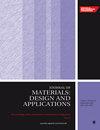用于高强度钢熔焊的厚丝 GMAW
IF 2.2
4区 材料科学
Q3 MATERIALS SCIENCE, MULTIDISCIPLINARY
Proceedings of the Institution of Mechanical Engineers, Part L: Journal of Materials: Design and Applications
Pub Date : 2024-09-17
DOI:10.1177/14644207241283273
引用次数: 0
摘要
本文介绍了一种大电流气体金属弧焊(GMAW)工艺,使用直径达 4.0 毫米的焊丝电极,对 20 毫米厚的钢板进行单道全熔透对接焊接。基础研究旨在通过确定焊接性能和可实现熔敷率的极限,将粗焊丝 GMAW 发展成为一种高效方法。目前在设备要求、工艺性能、应用领域和焊接质量等方面存在认识差距。该研究项目通过对基本技术分析、应用样板焊接和质量评估的系统研究来弥补这些差距。项目的目标是创建一种稳健、经济高效的高性能气体保护焊接技术,其熔敷率可与埋弧焊相媲美。全机械化自动焊接装置包括两个并联的焊接电源、一个送丝机和一个大功率焊枪。对焊接参数和条件进行了评估,目的是获得高质量的焊缝。确定了 20 毫米厚钢板单面单道焊接的最佳参数。通过在 S690Q 级钢板上进行双面单道焊接,验证了 20 毫米厚高强度钢的厚丝 GMAW 焊接工艺。对焊接接头的测试包括静态拉伸强度测试(3x 拉伸试样)、-40 °C夏比冲击测试(6x 夏比 V 型缺口试样,缺口位置分别位于焊接金属、母材和热影响区(HAZ))、微观结构检查和硬度测试。据观察,在焊接金属中记录到的最低冲击能量为 50 J,同时热影响区的硬度峰值达到 415 HV1,所有拉伸试样均在母材内的热影响区外失效。该工艺实现了可靠、可重复和经济的接头焊接,符合必要的机械技术质量标准。这篇论文加深了人们对选定的厚板焊接技术的理解,并提供了宝贵的工业见解,证明了该技术在高强度应用领域的适用性和可行性。本文章由计算机程序翻译,如有差异,请以英文原文为准。
Thick-wire GMAW for fusion welding of high-strength steels
The paper describes a high-current Gas Metal Arc Welding (GMAW) process using wire electrodes with diameters up to 4.0 mm for single-pass full penetration butt joint welding of 20 mm thick steel plates. Fundamental research aims to develop thick-wire GMAW into a high-efficiency method by identifying the limits of welding performance and achievable deposition rates. Current gaps in understanding include equipment requirements, process properties, application fields, and weld quality. The research project addresses these gaps through systematic investigations of basic technological analyses, application sample welding, and quality evaluations. The objective was to create a robust, cost-efficient gas-shielded high-performance welding technology with deposition rates comparable to Submerged Arc Welding. The fully mechanized, automatic welding setup included two parallel-connected welding power sources, one wire feeder and one high-power welding torch. Welding parameters and conditions were evaluated with the aim of achieving a high-quality weld. Optimal parameters were identified for one-sided single-pass welding on 20 mm thick plates. Validation of thick-wire GMAW for 20 mm thick high-strength steels was conducted via two-sided single-pass welding on S690Q grade plates. Testing of the weld joint included static tensile strength test (3x tensile specimen), a Charpy impact test at −40 °C (6x Charpy V-notch specimens respectively with notch position in weld metal, base material and heat-affected zone (HAZ)), microstructure examination and a hardness test. The lowest recorded impact energy was observed to be 50 J within the weld metal, in combination with hardness peaks in the HAZ reaching 415 HV1, and all tensile specimens failing outside the HAZ within the base material. The process achieved reliable, reproducible, and economical joint welding, meeting necessary mechanical-technological quality standards. The paper enhances the understanding of selected welding techniques tor thick plate joining and offers valuable industrial insights, demonstrating the technique's applicability and feasibility for high-strength applications.
求助全文
通过发布文献求助,成功后即可免费获取论文全文。
去求助
来源期刊

CiteScore
4.70
自引率
8.30%
发文量
166
审稿时长
3 months
期刊介绍:
The Journal of Materials: Design and Applications covers the usage and design of materials for application in an engineering context. The materials covered include metals, ceramics, and composites, as well as engineering polymers.
"The Journal of Materials Design and Applications is dedicated to publishing papers of the highest quality, in a timely fashion, covering a variety of important areas in materials technology. The Journal''s publishers have a wealth of publishing expertise and ensure that authors are given exemplary service. Every attention is given to publishing the papers as quickly as possible. The Journal has an excellent international reputation, with a corresponding international Editorial Board from a large number of different materials areas and disciplines advising the Editor." Professor Bill Banks - University of Strathclyde, UK
This journal is a member of the Committee on Publication Ethics (COPE).
 求助内容:
求助内容: 应助结果提醒方式:
应助结果提醒方式:


